20Shift: Your Daily Dose of Insight
Stay updated with the latest trends and news across various domains.
Navigating the Browser Maze: A Compatible Journey
Unlock the secrets of browser compatibility and enhance your online experience with our guide to navigating the digital maze!
Understanding Browser Compatibility: What You Need to Know
Understanding browser compatibility is essential in today's digital landscape, as it ensures that your website functions optimally across various web browsers. Different browsers—such as Google Chrome, Mozilla Firefox, Safari, and Microsoft Edge—interpret code in slightly different ways. This can lead to inconsistencies in how your website is displayed, which can frustrate users and potentially drive them away. To achieve a consistent experience for all users, developers must test their websites on multiple browsers and address any quirks or issues that arise during these tests.
There are several factors to consider when optimizing for browser compatibility:
- HTML/CSS Standards: Stick to standard coding practices to minimize compatibility issues.
- JavaScript Functionality: Keep in mind that not all JavaScript features are supported across all browsers.
- Responsive Design: Ensure that your website looks good on various screen sizes, as different browsers may render layouts differently.

The Essential Guide to Cross-Browser Testing: Ensure a Seamless Experience
Cross-browser testing is a crucial process that ensures your website or application performs consistently across different web browsers and devices. With the diverse ecosystem of browsers like Chrome, Firefox, Safari, and Edge, each may render your content differently due to varying rendering engines and user settings. By prioritizing cross-browser testing, you can identify inconsistencies and issues, which not only enhances user experience but also builds credibility and trust with your audience. Embracing this practice helps to ensure a seamless experience for every visitor, leading to higher engagement and conversion rates.
To implement effective cross-browser testing, follow these essential steps:
- Identify Target Browsers: Determine which browsers and versions your audience predominantly uses.
- Automate Testing: Utilize tools like Selenium or BrowserStack to automate the testing process, saving time and resources.
- Conduct Regular Checks: Make cross-browser testing a routine part of your development cycle to catch issues as they arise.
- User Feedback: Encourage users to report discrepancies they encounter, providing valuable insight into potential problems.
Top 10 Tips for Navigating Browser Differences: A User's Perspective
Navigating browser differences can often feel like a daunting task, especially for users who are not tech-savvy. Different browsers, such as Chrome, Firefox, and Safari, may display web pages in varying ways, which can lead to inconsistencies in your online experience. To make the most out of your browsing sessions, it’s crucial to understand these differences and adapt accordingly. Here are some valuable tips:
- Keep your browsers updated: Regular updates ensure you have the latest features and security patches.
- Test on multiple browsers: Before finalizing content, ensure it renders well across different platforms.
- Utilize browser developer tools: These tools help diagnose issues like layout problems and slow loading speeds.
- Check browser compatibility: Websites can behave differently, so use resources to verify compatibility.
- Use extensions wisely: Enhance your browsing experience, but avoid cluttering your browser with unnecessary add-ons.
- Consult browser-specific support communities: Many browsers have forums where users share solutions to common issues.
- Stay aware of privacy settings: Adjust them according to your comfort level with data sharing.
- Be patient: Some features may load differently, so give it time.
- Adapt to new technologies: Keep an eye on emerging tools that can improve your browsing experience.
- Enjoy the learning process: Each browser offers unique features, so take the time to explore them.